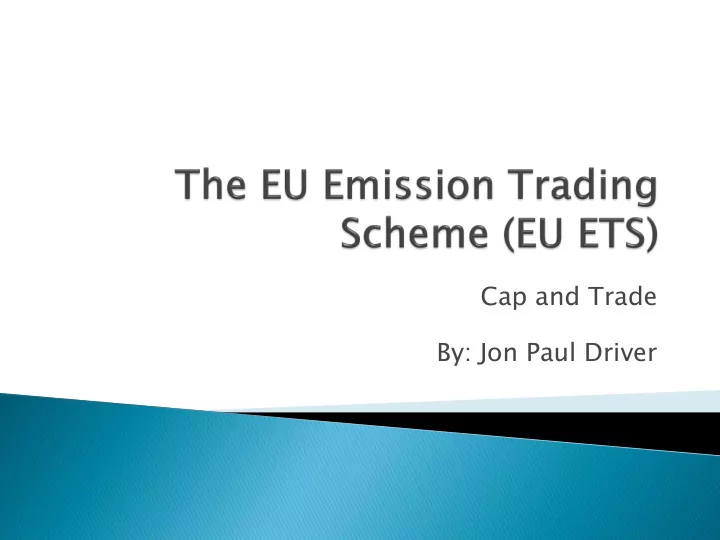

Cap and Trade By: Jon Paul Driver
Origins The basics Time Periods Market Functions Problems
Origins Earth Summit (Rio de Janeiro): 1992 Kyoto Protocol : 1997 European Climate Change Program (ECCP): 2001 EU Ratification of Kyoto Protocol: 2002
Each member state: ◦ Measures its own emissions ◦ Sets its own emission reduction goals Belgium -15%, Germany -14%, Poland +14%, ◦ Develops “National Allocation Plan” ◦ Reports to the EU EU has power to veto proposal ◦ Allocates emissions to companies for free ◦ Countries “own” emission rights
◦ Experimentation ◦ Allowances determined by the member states National Allocation Plan (NAP) Yearly Reports ◦ Member states could ask for exclusions if their laws already accounted for a equivalent amount of reduction ◦ Exclusions for certain installations in case of “Force Majeure” ◦ 5% Auctioning
◦ Coincide with the Kyoto commitment ◦ Allowances still determined by the member states (NAPII) ◦ Reform in monitoring and reporting Completeness, consistency, transparency, accuracy, cost- effectiveness, faithfulness and improved performance ◦ Inclusion of Nitrous Oxide ◦ 10% Auctioning
Single EU wide cap ◦ Member states do not set the cap ◦ 1.9 billion tonnes Inclusion of ◦ Planes and Boats More extensive auctioning
Auctioning Markets Penalties
“At least 50% of the proceeds from auctioning should be used for climate-related adaption and mitigation purposes” Reasons ◦ Polluter Pays Principle
Power Plants Year % of a auctioning oning 2013 100% Power r Plants (New w 2013 13 30% 30% Member er States) es) 2020 100% Manufac ufactu turin ing 2013 13 20% 20% 2020 70% 2027 100%
9 Markets (pointcarbon.com) ◦ EU ETS ◦ CDM & JI ◦ Nord Pool Price remains fairly low because of competition between the different markets
Phase I allowances € 32 Phase II allowances € 28 € 24 € 20 € 16 € 12 € 8 € 4 € 0 Dec- Feb- Apr- Jun- Aug- Oct- Dec- Feb- Apr- Jun- Aug- Oct- Dec- Feb- Apr- Jun- Aug- Oct- 04 05 05 Source: Point Carbon 05 05 05 05 06 06 06 06 06 06 07 07 07 07 07
Companies emitting in excess of the allowance prescribed will incur a fine ◦ € 40/tonne of carbon dioxide equivalent from 2005-2007 ◦ € 100 after 2008, excess having to come out of the following year's allowance.
Economic Recession Carbon Leakage International Competition Auctioning and the European “playing field” Legal Battles
Manufac ufactu turin ing 2013 13 20% 20% 2020 70% 2027 100% Manufac ufactu turin ing 2013 13 15% 15% 2020 70% 2027 100%
Carbon bon lea eakage age ◦ occurs when there is an increase in carbon dioxide emissions in one country as a result of an emissions reduction by another country with a stricter climate policy. Carbon leakage may occur if ◦ environmental policies in one country add a premium to certain commodities, then the demand may decline and their price may fall. Countries that do not place a premium on those items may then take up the difference in production.
Who is going to bear the burden of cleaning up within the EU? How will EU companies compete with companies outside the EU? ◦ Give more credits ◦ Tax incoming goods
Companies vs. the EU ◦ Article 230 Countries vs. the EU ◦ Difference in industries
Energy-intensive sectors are likely to end up with a very considerable number of unused freely allocated allowances which can be carried over into phase 2013-2020. There are already measures in place to help energy intensive industries: free allocation and access to international credits. Unused free allowances have been monetized. Investment in low-carbon technology in energy-intensive sectors has strengthened their overall productivity.
Recommend
More recommend